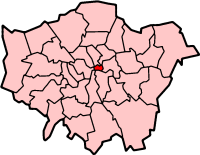This is an old revision of this page, as edited by Steeev (talk | contribs) at 00:21, 5 December 2003 (* Museum of London website: http://www.museumoflondon.org.uk). The present address (URL) is a permanent link to this revision, which may differ significantly from the current revision.
Revision as of 00:21, 5 December 2003 by Steeev (talk | contribs) (* Museum of London website: http://www.museumoflondon.org.uk)(diff) ← Previous revision | Latest revision (diff) | Newer revision → (diff)
The City of London, often referred to as just the City or as the Square Mile (from its area) forms the historic and financial centre of Greater London.
| City of London | |
 | |
| Demographics | |
|---|---|
| Population: | 7,200 (2001) |
| Ethnicity: | 85% white, 4% bangla, 2% indian, 2% chinese |
| Geography | |
| Villages: | Barbican |
| Neighbours: | Camden, Hackney, Islington, Tower Hamlets, Southwark, Westminster |
| Stations: | Liverpool St., Fenchurch St. Bank |
| Politics | |
| Executive: | Independent Conservatives |
| MPs: | Mark Field |
| GLA: | City and East London |
The City of London is administered by the Corporation of London, headed by the Lord Mayor of London. It has its own independent police force, the City of London Police, unlike the rest of Greater London which is policed by the London Metropolitan Police, based at Scotland Yard. It is also unusual in that businesses are allowed to vote in the local government elections. The City is a ceremonial county and has its own Lord-Lieutenant.
The City itself has two independent enclaves within it - Inner Temple and Middle Temple.
Extent
The size of the City was originally constrained by a defensive perimeter wall, known as 'London Wall', that was built by the Romans to protect their strategic port city. Even though the walls have long since crumbled away and been broken up, the City of London still retains the same size and shape it had back then.
The City of London borders the City of Westminster to the west - the border cutting through Victoria Embankment, passing to the west of Middle Temple, going east along Strand/Fleet Street, north up Chancery Lane, where it becomes instead the border with the London Borough of Camden. It continues north to Holborn, turns east, continues, then goes northeast to Charterhouse Lane. As it crosses Farringdon Road it becomes the border with the London Borough of Islington. It continues to Aldersgate, goes north, and turns into some back streets soon after it becomes Goswell Road. It ends up on Ropemakers Lane, which as it continues east past Moorgate becomes South Place. It goes north, becomes the border with the London Borough of Hackney, then east, north, east on backstreets, meeting Norton Folgate at the border with the London Borough of Tower Hamlets. It continues south into Bishopsgate, and takes some backstreets to Middlesex Street where it continues south-east then south. It makes a divergence to the west at the end of Middlesex Street to allow the Tower of London to be in Tower Hamlets, and then reaches the river.
At its maximum extent the City included areas now not part of it, including Southwark (as the 'ward of bridge without'). The City today has control all over London Bridge, but only half of the river underneath it.
History
It has been administered separately since 886 when Alfred the Great appointed his son-in-law Ethelred Governor of London. Alfred made sure there was suitable accommodation for merchants from north west Europe, which were then extended to traders from the Baltic and Italy.
The City developed its own code of law for the mercantile classes, developing such an autonomy that Sir Laurence Gomme regarded the City as a separate Kingdom making its own laws. In the tenth century Athelstan permitted eight mints to be established as against six in his capital, Winchester, indicating the wealth of the city. The City was composed of wards governed by Aldermen, who chaired the Wardmotes. There was a folkmoot for the whole of the city held in the shadows of St Paul's Cathedral.
Following the Battle of Hastings, William the Conqueror marched on London, to Southwark and failed to get across London Bridge or to defeat the Londoners. He evenually crossed the River Thames at Wallingford, pillaging the land as he went. Rather than continuing the war Edgar Atheling, Edwin of Mercia and Morcar of Northumbria surrendered at Berkhamstead. London was rewarded by 1075 William granted the citizens a charter. The City of London was one of the few Institutions where the where English retained some authority.
However, William insured against attack by building 3 Castles to keep the Londoners subdued:
In 1132 Henry I recognised full County status for the city and by 1141 the whole body of the citizenry was considered to constitute a single community. This was the origin of the Corporation of London.
Elections

Arms of the City of London
The City of London (Ward Elections) Bill, which will reform the current voting system for electing Members to the Corporation of London, passed its final hurdle by getting approval from the House of Lords at the end of October 2002.
Under the new system, the business vote will be increased by 16,000 to 32,000. Previously disenfranchised firms will be entitled to nominate voters, in addition to those already included in the business vote, and will be required to choose these voters in a representative fashion. The Bill will also remove other anomalies that have developed over time within the current system, which has been unchanged since the 1850s.
See Also
External links
- City of London website: http://www.cityoflondon.gov.uk
- Museum of London website: http://www.museumoflondon.org.uk